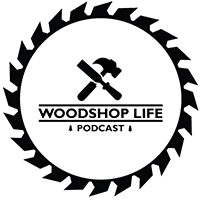Support us on Patreon: https://www.patreon.com/woodshoplife
Sean
1) My question for you is regarding finishing. I have used an alcohol based dye and sealed it with shellac as ‘it sticks to everything and everything sticks to it’. I’m also using a water based poly over that. Specifically regarding the legs, they are an upside down ‘U’ shape or ‘A’ shape and I have them set up to brush on the poly. Would you finish the outward face and edges first, let dry and then flip to do the inner face (legs are laying flat on painters pyramids that are set up on top of the table saw). Or would you poly all sides at once and try to touch up finger marks as you go?
If I were to spray the poly, what would be my order of operations (spray one side and all edges first or all sides at once). What about orientation of the table legs (lay flat/ stand them up/hang from a wire?)
The poly I’m using is Zar Premium Finishes fast drying semi gloss. It says on the container ‘do not thin’ if spraying can I disregard this and add up to 10% water to lower the viscosity as I might with other finishes?
Thank you so very much for such an in depth dive into this glorious craft. Bruce
2) Thanks for answering my last question on stickering new cherry boards in a horizontal rack. I did sticker them and they stayed stable but in the future I will probably not if they are kiln dried as I have limited space and need to maximize.
I just completed a shaker end table with the cherry I had bought and realized when putting the top on that the painter’s pyramids that I used to hold the top while I was applying the finish left dents in the top. I finished the top with a coat of BLO and then five coats of shellac. The finish looks great but the dents are ruining the look of the smooth top. I know you can steam the dents out but I am afraid to try this as I do not want to damage the finish. What are your thoughts or suggestions?
Thanks again,
Jim
Guy
1) Hi guys… I’m a truck driver and listen to your podcast allot.
Guy,, do you still use your Incra TSLS fence? Why don’t we see more woodworkers using them? Even on YouTube the videos are years old. Your thoughts please. Brent
2) Name a tool that you have that you’re not particularly happy with, but for some reason have not upgraded, and give your reasons why you haven’t bit the bullet and bought a better version of that tool?
Huy
1) Gentlemen- I [insert enthusiastic verb] your podcast, and think you all are etc..I have a…different…finishing question. I am about to complete a small timber framed shed. No fasteners used except 4 hurricane straps and nails for the roof deck. Guy you would hate your life here all the mortise and tenon joinery was cut by hand. The frame base, flooring, and siding are black locust, the rest of the beams are SPF. All locally sawn, and then transported on the roof of my Subaru. The roof is going to be a living moss roof (i have no lawn only moss on 4 acres). I went through the trouble of bookmatching the siding when I made it, and even though black locust will last 100 years outdoors, I would like to, as the kids say, “pop” the grain. Would you recommend any sort of oil-based finish? I know i would have to reapply periodically which isn’t a problem, however sanding would be. I live about an hour outside of NYC, we have seasons. Any other info you need feel free to ask. Thanks. Tom
2) I recently bought a combination machine (itech c300). It’s a HUGE step up for me, and I’m worried about neglecting something because of my own ignorance. What would you say are requirements for servicing induction motors? Any other tips or tricks for someone who has just upgraded to a serious piece of kit for the first time?
